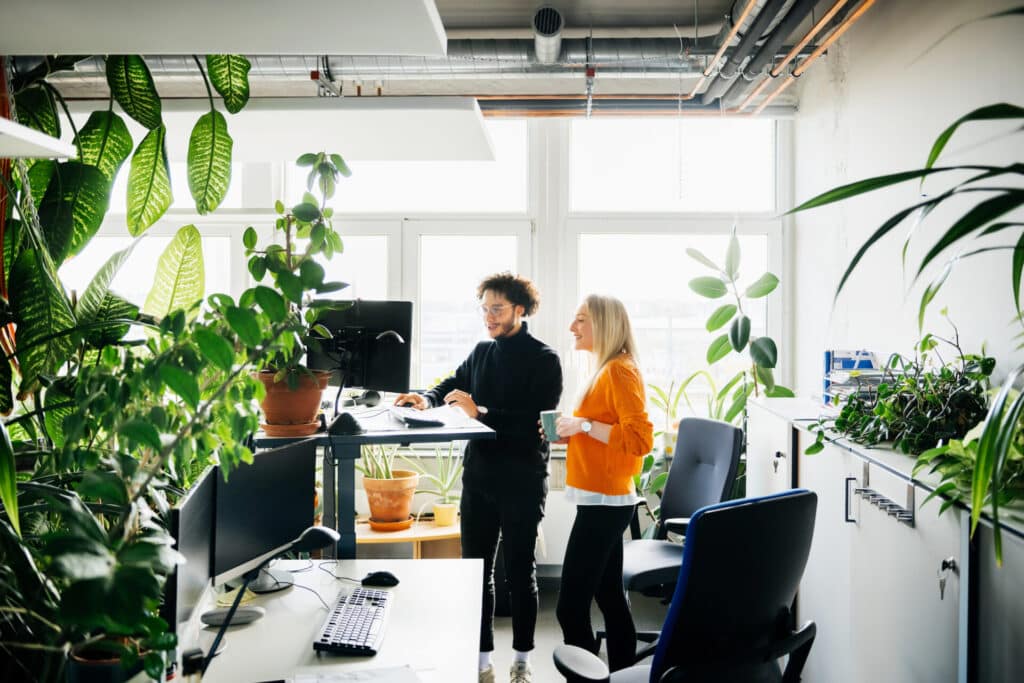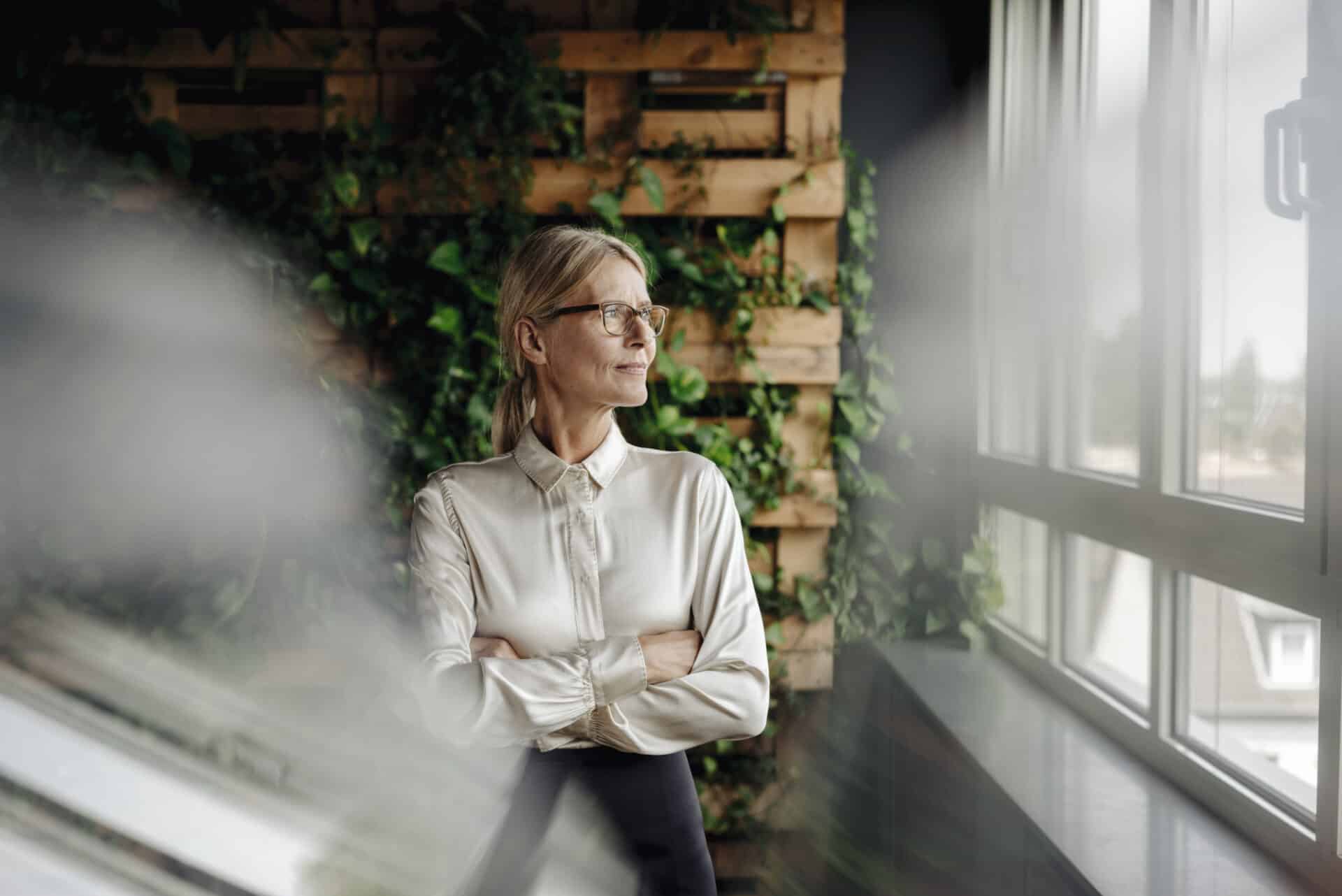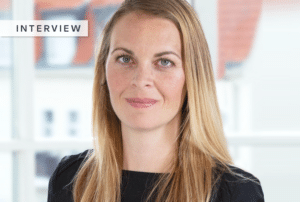The office as we know it is changing. In this post, we consider what the office of the future will look like—and explore the key trends behind it.
The pandemic took many of us out of the office suddenly and unexpectedly. Now, a few years on, the physical office is making a comeback—but a lot has changed.
The office is no longer a space that people use day in, day out, and nor is it a place they’re forced to spend time. With the majority of US companies operating a hybrid model, the role and purpose of the office is evolving.
The office of the future is somewhere that employees gladly commute to. It’s a welcome alternative to working from home; a space that inspires and connects people, fosters community and collaboration, and prioritizes comfort and well-being. Keep on reading to delve deeper into how the office of the future is evolving.
Table of Contents
- The Office of the Future Will Be Greener and More Sustainable
- Built for Community, Connectedness, and Collaboration
- Primed for Hybrid Work
- The Office of the Future Will Be Flexible, Customizable, and Adaptive
- Designed for Comfort and Well-Being
- Designing (or Redesigning) Your Office for the Future
The Office of the Future Will Be Greener and More Sustainable
A Pew Research Center survey found that 69% of Americans are in favor of the US becoming carbon-neutral by 2050. At the same time, 68% of employees claim they would be more willing to accept a job offer from an environmentally sustainable company.
Take, for example, the impressive new office block built on the United Nations campus in Geneva. The design incorporates hydrothermal technology that uses water from nearby Lake Geneva to heat and cool the building, while solar panels on the roof help to make the office more energy efficient.
While not all offices will have the benefit of such advanced technology, or of being situated right next to a lake, office design will increasingly prioritize the environment. The office of the future will utilize more eco-friendly materials such as bamboo and timber, favor natural light and ventilation, and seek to run on energy-efficient systems.
Built for Community, Connectedness, and Collaboration
In pre-pandemic times, the office had to cater to all different aspects of the working day—from solo and focused work to meetings, workshops, and social interactions.
Since the pandemic, most office workers (and their employers) have noticed that working away from the office is great for productivity. A Stanford study of over 16,000 employees found that working from home can increase performance by up to 13%.
The office of the future will not seek to replicate the kind of focus that can be achieved at home. Rather, it will be designed to give people something they may well miss out on while working remotely: a sense of community and connectedness.
Where possible, people will split their time between home and the office—choosing the former for productivity and focus and the latter when they seek to be inspired, to connect with their teammates, and to enjoy the communal atmosphere.
Offices will evolve into collaborative hubs, designed to encourage people to gather, chat, brainstorm, and co-work, or simply hang out, listen to music, play games, or work out. Think Google’s indoor rock climbing wall or the listening rooms and libraries at Spotify HQ.
Curious about how our solutions can be applied in real-world scenarios?
Learn how we enhance workplace safety, globalization, customer support, and more!
Primed for Hybrid Work
74% of US companies are either following a hybrid working model or planning to do so in the future. Offices will be designed to accommodate this “new normal”, fostering seamless collaboration between onsite colleagues and those working remotely.
The goal will be to create spaces where it feels like everybody is present—even if they’re logging in from home. Google has led the way with their campfire conference room concept, a circular meeting space that incorporates seating and large screens, giving everybody a designated place in the room and evoking the sense of a huddle or gathering (like gathering round a campfire).
Hybrid meetings of old typically involved remote attendees appearing as tiny squares on laptop screens, barely audible to those in the room. But, in the era of hybrid work, the office of the future will ensure that everybody is equally present—no matter where they’re dialing in from.
The Office of the Future Will Be Flexible, Customizable, and Adaptive
With the rise of hybrid work, the purpose of the office is changing. If people aren’t going to the office every day regardless of what they’re working on, you can bet that when they do make the commute, it’s because they’ve got a particular use in mind for the office space.
It might just be to co-work and catch up, as we discussed earlier when talking about the role of the office in facilitating community and connectedness. It might be to lead or attend specific workshops, to have a mentor/mentee one-to-one, or to do deep-focus work with the option of meeting colleagues for lunch.
The point is, the office of the future will need to be customizable and adaptive. It will need to be whatever the employee needs it to be on any given day. Physically and spatially, the office of the future will be malleable. Think flexible, moveable partitions and modular furniture that can be put together in different configurations and pulled apart again, like Lego.
At the same time, employers will increasingly integrate technology, data, and real-time analytics to monitor how office space is being used. Based on this data and the trends it uncovers, the office of the future will be adapted and optimized continuously to meet employees’ needs.

Designed for Comfort and Well-Being
If employees can choose where they work, a comfy couch at home or the charming surroundings of a nice local café will win over a bland, uncomfortable office every time.
But the office of the future won’t be either of those things. Increasingly, offices will start to mimic the spaces where we choose to spend our downtime. They’ll feel more like boutique hotel lounges and hip coffee shops—a far cry from the often sterile, dull, and dreary offices of the past.
The office of the future will be designed to maximize natural light and incorporate elements of nature; think skylights and floor-to-ceiling windows, green walls, and water features à la biophilic design.
Wellness and well-being will also take priority. As employers strive to support mental health in the workplace, they will seek to design environments that foster connectedness and belonging while also encouraging rest and relaxation.
Essentially, employers (and designers) will aspire to create spaces that people want to be in. The ultimate office of the future will be a comfortable, uplifting, and all-around pleasant environment where employees feel good and can do their best work.
Designing (or Redesigning) Your Office for the Future
You might not have the budget or the real estate that companies like Spotify and Google have, but you can still design (or redesign) your office for the future.
Consider how the role of your office has changed in the last few years. Do you still have everybody coming in every day, or is the office one of several possible locations your employees can work from?
The goal is to create a space that meets your employees’ needs and is optimized for their preferred style of working. If you’re operating a hybrid model, you might choose to prioritize comfort and community in your office of the future—establishing a hub where people come to connect and collaborate.
If you’ve got most employees using the office most of the time, you might focus on designing a versatile, highly customizable space that facilitates both individual focus time and teamwork.
And remember: the office is just one part of your overall employee experience (EX). In addition to designing a comfortable and welcoming physical environment, make sure you’re also building a safe and healthy company culture. This includes helping your employees achieve a good work-life balance, creating a culture built on psychological safety, and supporting your employees with learning, development, and professional growth.
Transform your workforce with effective language training
Discover how tailored corporate language learning programs can enhance communication and collaboration in your organization.







